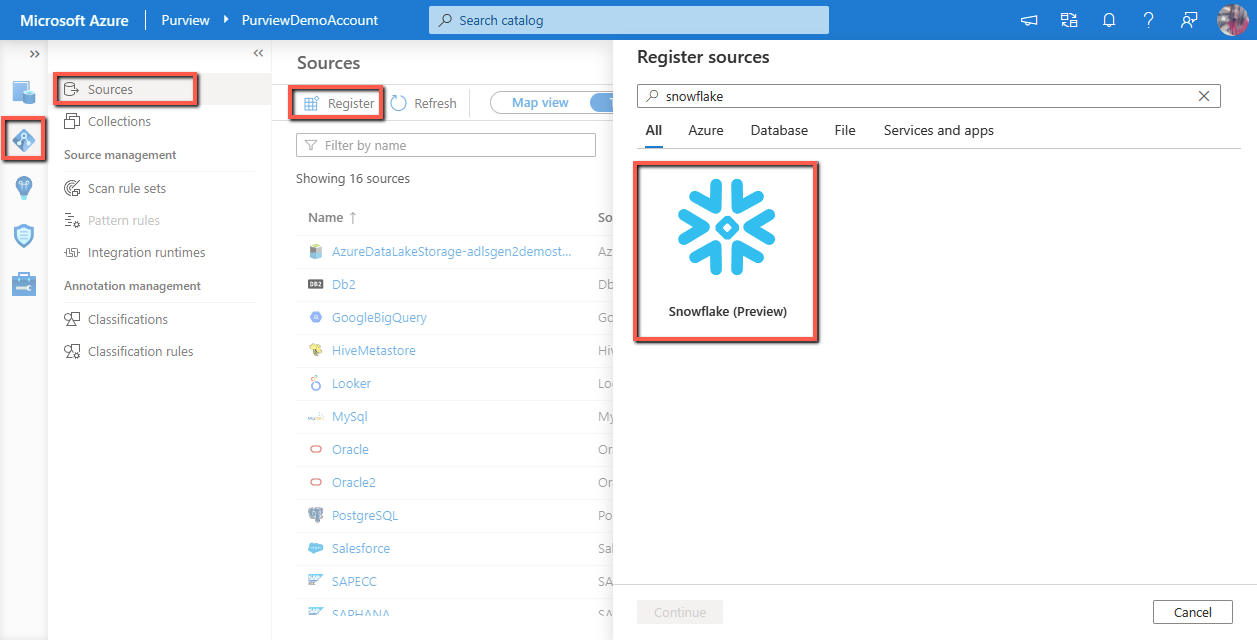Govern your Snowflake data with Azure Purview

Azure Purview as a unified data governance service keeps expanding support for various data sources across on-premises, multi-cloud, and SaaS applications. It helps you generate a holistic, up-to-date map of your data landscape with automated data discovery. Now you can easily bring over metadata from Snowflake by scanning your Snowflake databases, then manage and govern your Snowflake data in Azure Purview.
Register and scan
Azure Purview data source administrators can start by registering Snowflake under the data map, and set up reoccurring or one-time scan. You can choose to scan the entire Snowflake database(s) or scope the scan to selective schemas. When scanning Snowflake, Purview extracts rich set of metadata including Snowflake server, databases, schemas, tables, views, stored procedures, functions, pipes, stages, streams, tasks, sequences, and table/view/stream columns, as well as fetches static lineage on assets relationships among tables, views, and streams. Learn more about the prerequisites and step-by-step instruction to register and scan Snowflake in Azure Purview.
Search and browse assets
Once the scan completes, you can discover assets via search or browse.
You can search for the Snowflake assets by keyword, and narrow down results by using the facet filters.
To browse, click on the “Browse assets” tile on the Purview home page, navigate to the “By source type” tab and select Snowflake. You can then see the list of Snowflake assets brought in by the scan.
View and manage metadata
Click into the asset to view more details including the properties, schema, lineage, and more. You can also add business metadata like descriptions, glossary terms, and manually classify the data assets to further manage and govern your Snowflake data in Purview.
Get started today!
- Quickly and easily create an Azure Preview account to try the features.
- Learn more about Connect to and manage Snowflake in Azure Purview.
- See the full list of Azure Purview supported sources.
Published on:
Learn moreRelated posts
Semantic Reranking with Azure SQL, SQL Server 2025 and Cohere Rerank models
Supporting re‑ranking has been one of the most common requests lately. While not always essential, it can be a valuable addition to a solution...
How Azure Cosmos DB Powers ARM’s Federated Future: Scaling for the Next Billion Requests
The Cloud at Hyperscale: ARM’s Mission and Growth Azure Resource Manager (ARM) is the backbone of Azure’s resource provisioning and management...
Automating Business PDFs Using Azure Document Intelligence and Power Automate
In today’s data-driven enterprises, critical business information often arrives in the form of PDFs—bank statements, invoices, policy document...
Azure Developer CLI (azd) Dec 2025 – Extensions Enhancements, Foundry Rebranding, and Azure Pipelines Improvements
This post announces the December release of the Azure Developer CLI (`azd`). The post Azure Developer CLI (azd) Dec 2025 – Extensions En...
Unlock the power of distributed graph databases with JanusGraph and Azure Apache Cassandra
Connecting the Dots: How Graph Databases Drive Innovation In today’s data-rich world, organizations face challenges that go beyond simple tabl...
Azure Boards integration with GitHub Copilot
A few months ago we introduced the Azure Boards integration with GitHub Copilot in private preview. The goal was simple: allow teams to take a...
Microsoft Dataverse – Monitor batch workloads with Azure Monitor Application Insights
We are announcing the ability to monitor batch workload telemetry in Azure Monitor Application Insights for finance and operations apps in Mic...
Copilot Studio: Connect An Azure SQL Database As Knowledge
Copilot Studio can connect to an Azure SQL database and use its structured data as ... The post Copilot Studio: Connect An Azure SQL Database ...
Retirement of Global Personal Access Tokens in Azure DevOps
In the new year, we’ll be retiring the Global Personal Access Token (PAT) type in Azure DevOps. Global PATs allow users to authenticate across...




